Making consistently good bechamel is an indispensable technique to have in your cooking arsenal. This post outlines the tried and true ratios and methods that will make your bechamel turn out, every time.
It may seem a bit tricky if you haven’t made it before. Even if you have, maybe you’ve experienced some issues with texture like lumps, a sauce that's too thick, or a sauce that's too thin.
This post will provide you all the information you need to get exactly the right bechamel sauce for the dish you're preparing.
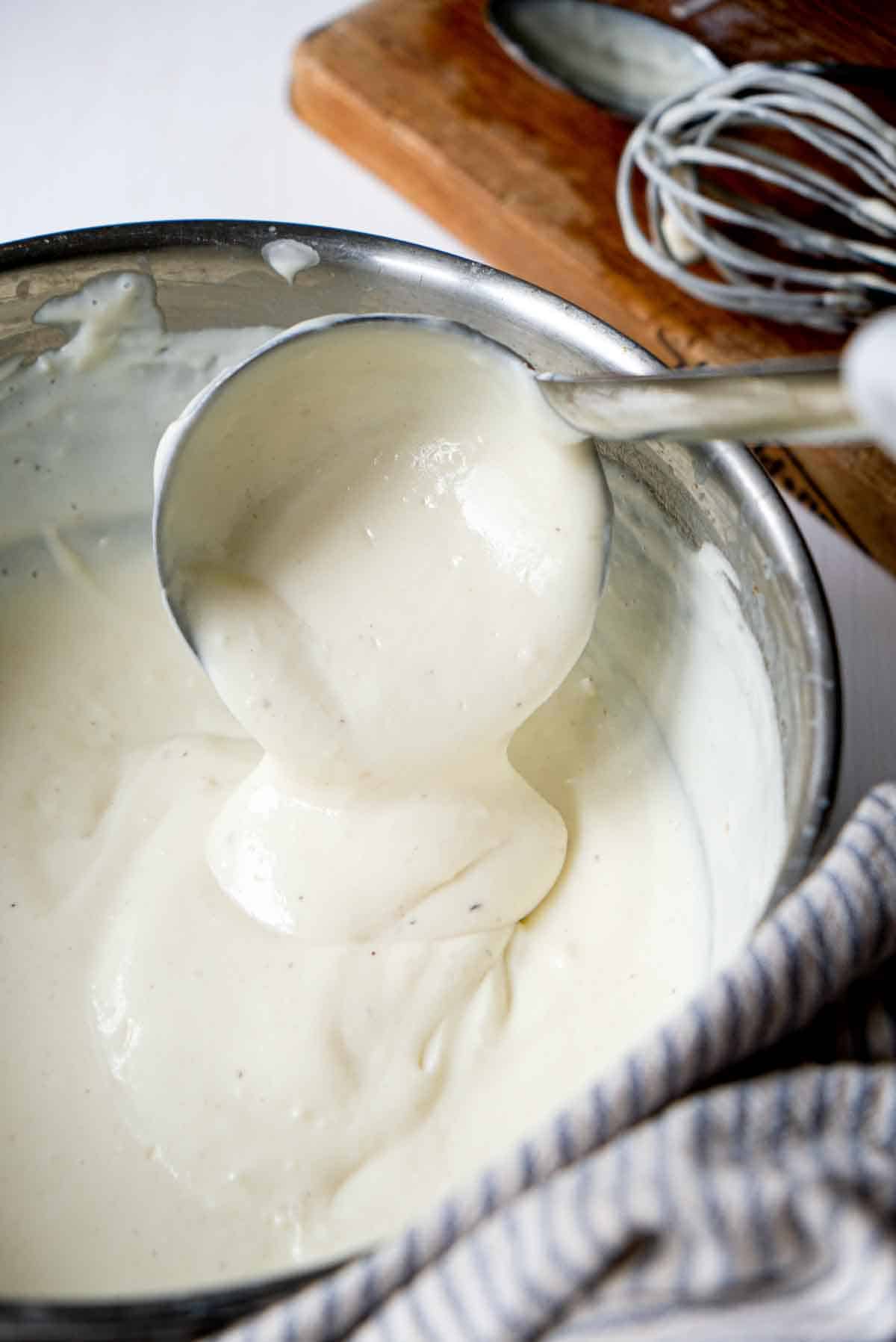
Bechamel is used extensively in many cuisines around the world including Italian, French, Greek, Spanish, Belgian etc. and in many well loved dishes like lasagna, moussaka, mac and cheese, croquettes, all sorts of gratins, creamy soups and even souffles. See below for ways to use bechamel.
The reason bechamel is used so extensively is no doubt because it’s so versatile and adaptable. It is of course one of the 5 classical French mother sauces. An elemental white sauce that provides a perfect base to build other derivative sauces like Nantua, Soubise, and cheese based Mornay sauce.
The simplicity and versatility of bechamel makes it a core skill to unlock for home cooks who are culinary enthusiasts and want to achieve more advanced dishes in their own home kitchens.
Summary
- The most important thing is to stir vigorously (fast and firm - but be careful it may be hot) and don't stop stirring until the mixture looks stringy like you're stirring a pot of melted mozzarella (see photos below).
- When choosing the right ratio, keep in mind the sauce will thicken quite a lot more once it cools. See photo comparison below.
- If the sauce is too thin, keep cooking and stirring until it thickens to your desired level.
- If the sauce is too thick, add more milk 1 tablespoon at a time while stirring constantly over heat.
- If there are lumps, heat and stir vigorously until smooth.
- If it's still lumpy, you can press the bechamel through a sieve with a spatula.
Jump to:
Bechamel Sauce Ingredients
When it comes to bechamel, there is not one "master recipe" or best recipe or ultimate for bechamel sauce. There are many different ways it's made by different cooks.
The reason there are many different recipes for bechamel is because bechamel can be made thin, medium, or thick depending on the intended use.
As such, what's more important than the recipe quantities, is the ratio of ingredients.
Bechamel sauce has just 3 essential ingredients:
- Flour
- Butter
- Milk
Many people would also consider nutmeg and salt as being essential ingredients, but in its most basic form it's this combination of flour, butter and milk.
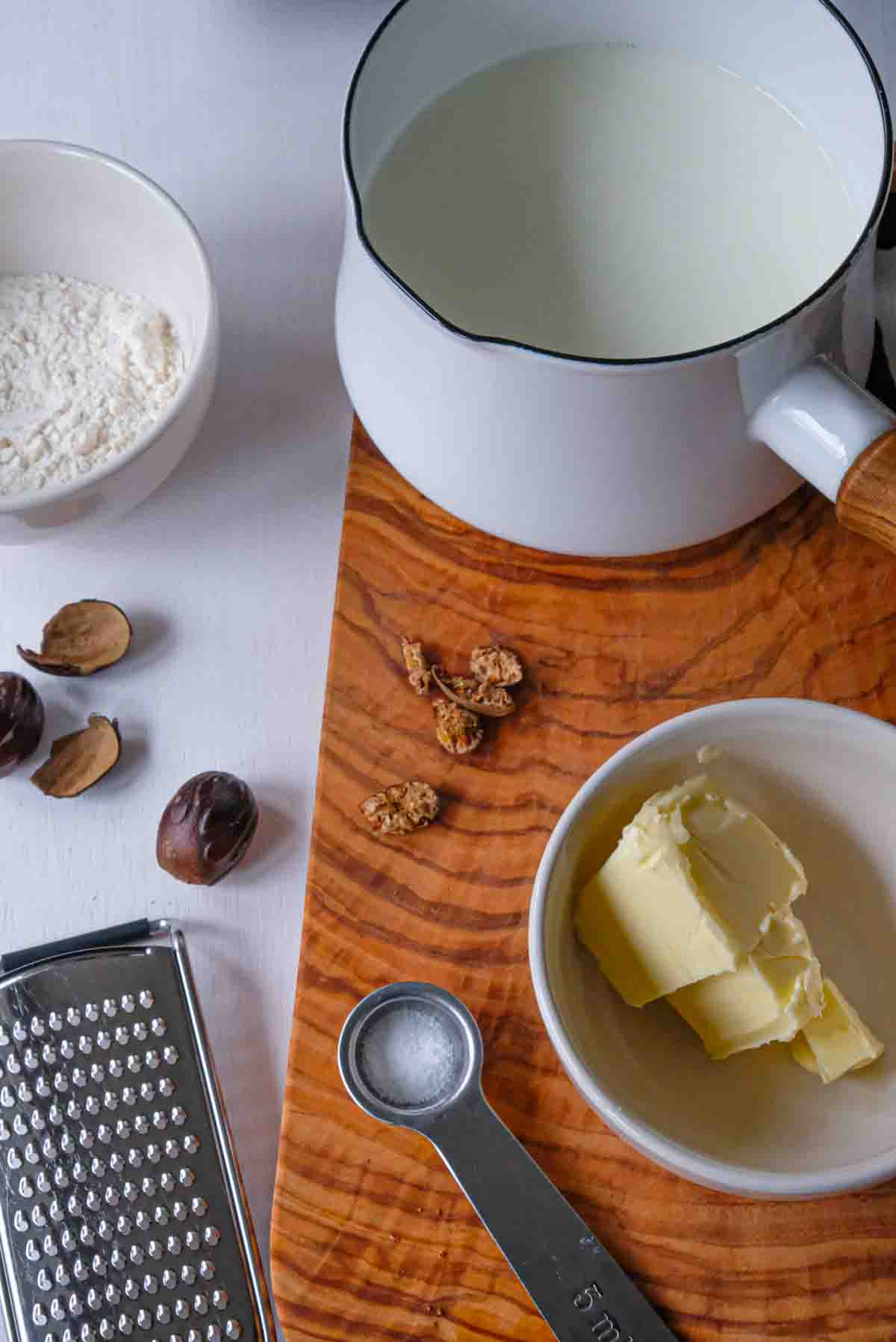
Flour & Butter = Roux: Flour cooked in butter (or more broadly, in fat) is called a roux. A roux is a base for thickening many different sauces, soups, and stews including velouté sauce (another of the classic French mother sauces) and classic Creole gumbo.
Bechamel Recipe Ratios for Different Thickness Sauces
Usually the flour and butter are either equal or close to equal (by weight) and together they make up from 12% all the way up to 36% of the milk by weight (depending on the desired thickness of the sauce).
This table shows the different thicknesses of bechamel as determined by different roux to milk ratios.
Metric: to make approximately 300ml of bechamel
| Sauce Type | Milk | Butter | Flour | Percentage of roux |
|---|---|---|---|---|
| Thin bechamel | 500ml | 31g | 31g | 12.5% |
| Medium bechamel | 500ml | 44g | 44g | 18% |
| Thick bechamel | 500ml | 59g | 59g | 23.5% |
| Souffle base bechamel | 500ml | 90g | 90g | 36% |
Volumetric: to make approximately 1.25 cups of bechamel
| Sauce Type | Milk | Flour | Butter | Percentage of roux |
|---|---|---|---|---|
| Thin bechamel | 2 cups | 3.5 tbsp | 2 tbsp | 12.5% |
| Medium bechamel | 2 cups | 5 tbsp | 3 tbsp | 18% |
| Thick bechamel | 2 cups | 7 tbsp | 4 tbsp | 23.5% |
| Souffle base bechamel | 2 cups | 10.5 tablespoon | 6 tbsp | 36% |
Seeing the percentage of roux to milk for different thicknesses of sauce is interesting when you consider the table below with common bechamel recipes.
The table below shows a few different bechamel sauce recipes from well-regarded cooks and cookbooks so you can see the differences and similarities between each.
| Recipe by: | Flour (grams) | Butter (grams) | Milk | Percentage of roux to milk (by weight) | Source |
|---|---|---|---|---|---|
| Julia Child et al. | 28 | 28 | 426ml | 13% | Mastering the Art of French Cooking by J. Child et al. |
| Marcella Hazan | 47 | 50 | 450ml | 21.5% | Essential of Classic Italian Cooking by Marcella Hazan |
| Gordon Ramsay | 25 | 25 | 300ml | 17% | How to make classic white sauce |
| Ina Garten | 34 | 57 | 1.5 cups milk, 1 cup cream | 15.5% | Pastitsio recipe |
| Mario Batali | 113 | 113 | 950ml | 24% | How to make Besciamella |
| Larousse Gastronomique editors | 40 | 40 | 500ml | 16% | Larousse Gastronomique |
| The Silver Spoon Kitchen | 25 | 50 | 500ml | 15% | The Silver Spoon |
Mario Batali and Marcella Hazan's recipes are thicker - which makes sense when you think of the type of bechamel that would be used to top a lasagna.
Classical French uses tend to differ though, instead using bechamel as a thin serving sauce or to be baked in a gratin rather than a topping. So we see a thinner bechamel recipes in Mastering the Art of French Cooking and Larousse Gastronomique.
Interesting also to see that Gordon Ramsay's recipe is for a thinner bechamel, which makes sense given he trained for three years in France and was mentored by French chef Guy Savoy.
Scaling Bechamel Sauce
In general, 500ml of milk will make approximately 300ml of medium thickness bechamel (2 cups of milk will make 1.25 cups of bechamel).
Use the table below to scale up or down your bechamel recipe:
| To make this much sauce: | Use this much milk: |
|---|---|
| 100 ml (0.4 cups) | 166ml (0.7 cups) |
| 236ml (1 cup) | 392ml (1.65 cups) |
| 473ml (2 cups) | 785ml (3.3 cups) |
| 946ml (4 cups) | 1570ml (6.6 cups) |
| 2365ml (10 cups) | 3926ml (16.5 cups) |
Equipment to make bechamel
The following are highly recommended:
- A heavy bottomed sauce pan (like enameled cast iron or stainless steel): A heavy bottomed sauce pan that fits at least 6 liters / 6 quarts and can remain stable while you're doing very vigorous whisking. If you don't have a heavy-bottomed sauce pan then choose something heavy or that you can easily grip and hold still while you whisk.
- A small to medium sized wire whisk: A wire whisk is best as it can more effectively "cut" through the emulsifying starches, which reduces the chance of lumps forming. A silicone whisk would likely not be as effective since the thickness and slipperiness make it more likely to push aside clumps rather than cutting through them.
Bechamel Sauce Preparation Method
The most important thing to make a smooth lump-free bechamel is to whisk vigorously as you add the milk. The temperature of the milk and how you add it doesn't matter as much.
As is often the case with simple recipes, the preparation method used can make all the difference.
- Measure out the flour, butter and milk for your desired sauce thickness and set them close to the stovetop. The process will go very quickly so it should all be at hand.
- Preheat the sauce pan over medium heat.
- Add the butter to the pan and melt it (but don't brown or burn), then add the flour as soon as it's melted. You can also add both at the same time as I have, just make sure the butter doesn't brown on the edges before melting in the center.
- Use the whisk to mix the butter and flour until they are well-combined, and cook the mixture for 3-5 minutes adjusting the temperature as necessary to make sure it doesn't brown. It should begin to smell slightly sweet and nutty. It is okay if it clumps together at this stage, just keep stirring it.
- With the whisk in one hand, pour in the milk in a bit at a time (as little as a quarter cup at a time) and whisk it as fast as is safe, being careful not to splash. It may be helpful to have someone assist you at this stage. The bechamel should take on a stringy consistency, as you see below in the fifth photo.
- Continue adding milk while whisking, scraping along the edges of the saucepan to reincorporate any bits sticking to the edges of the pan (these can cause lumps later if not mixed in as you go).
- Once all the milk has been poured in, keep cooking for 3-5 minutes while stirring continuously.
- Turn off heat and season as you like (optionally ½ teaspoon salt and ¼ teaspoon nutmeg).
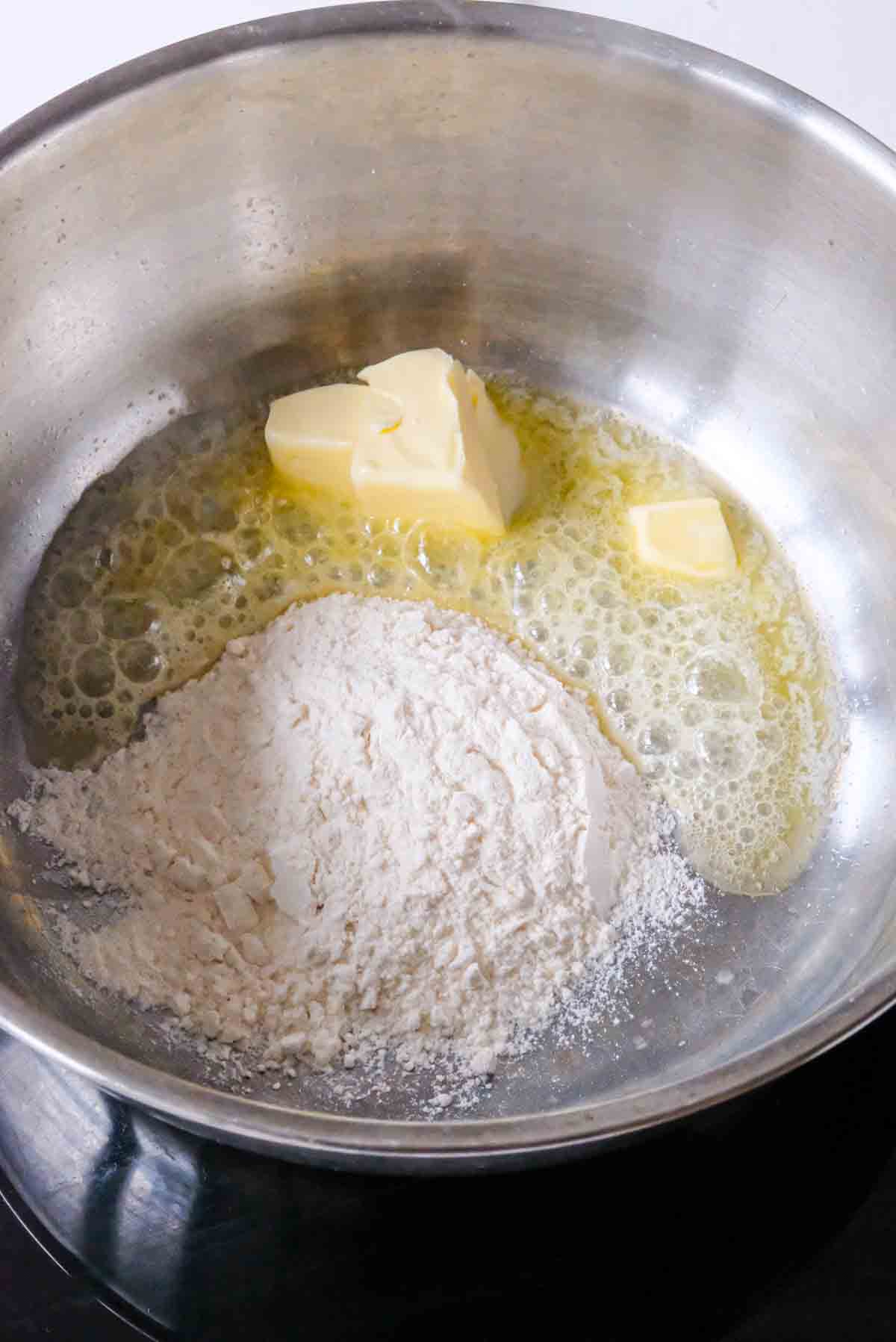

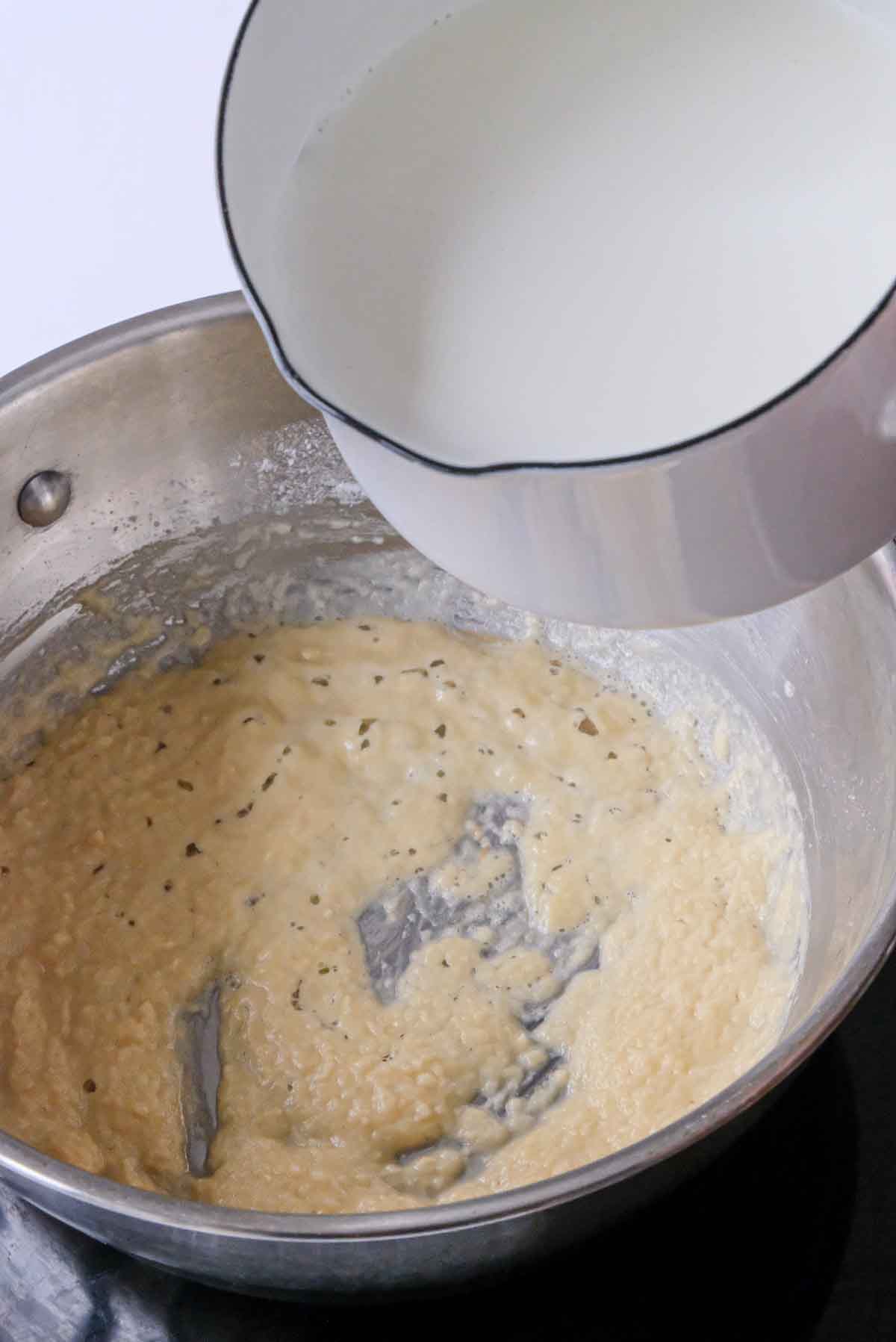
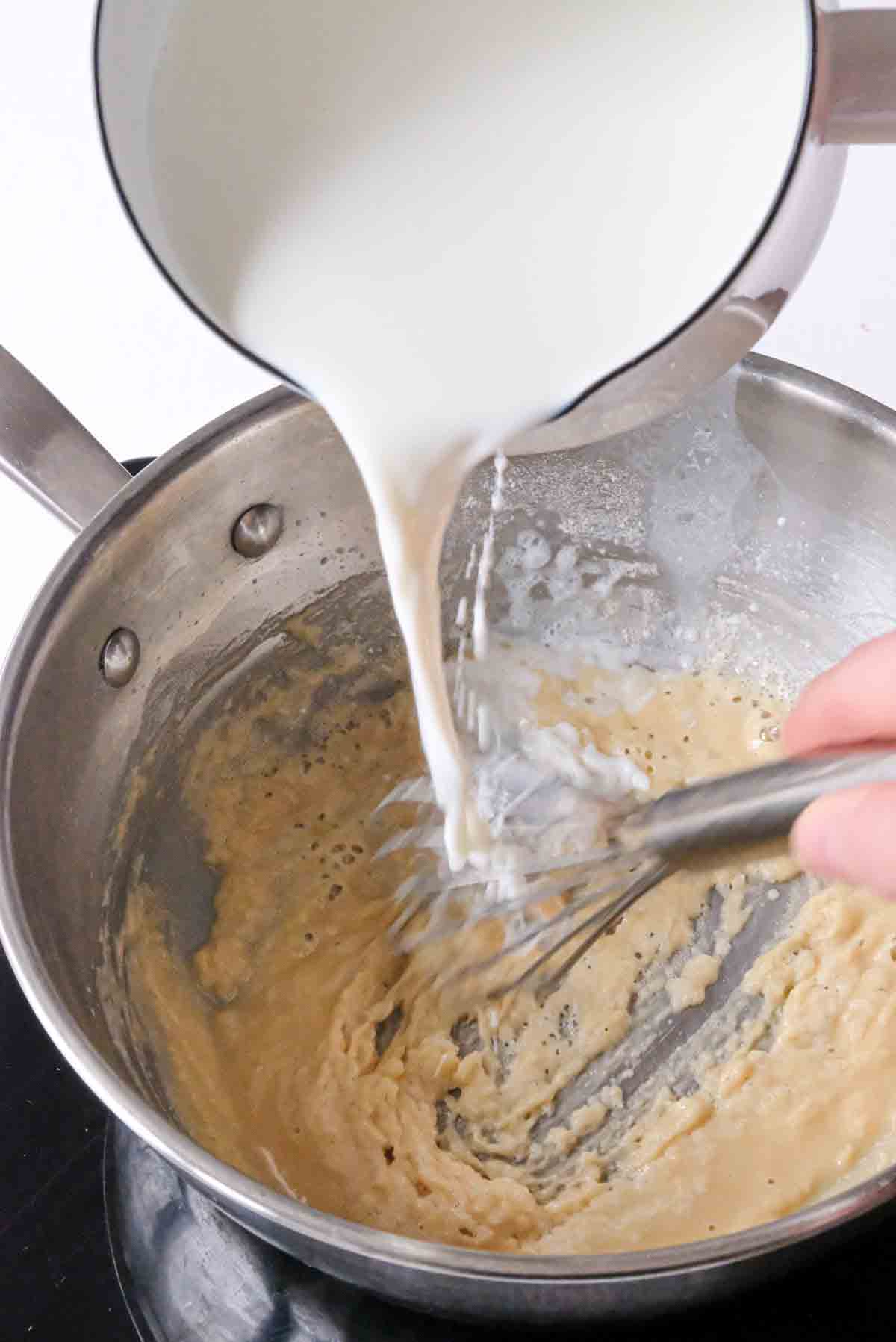
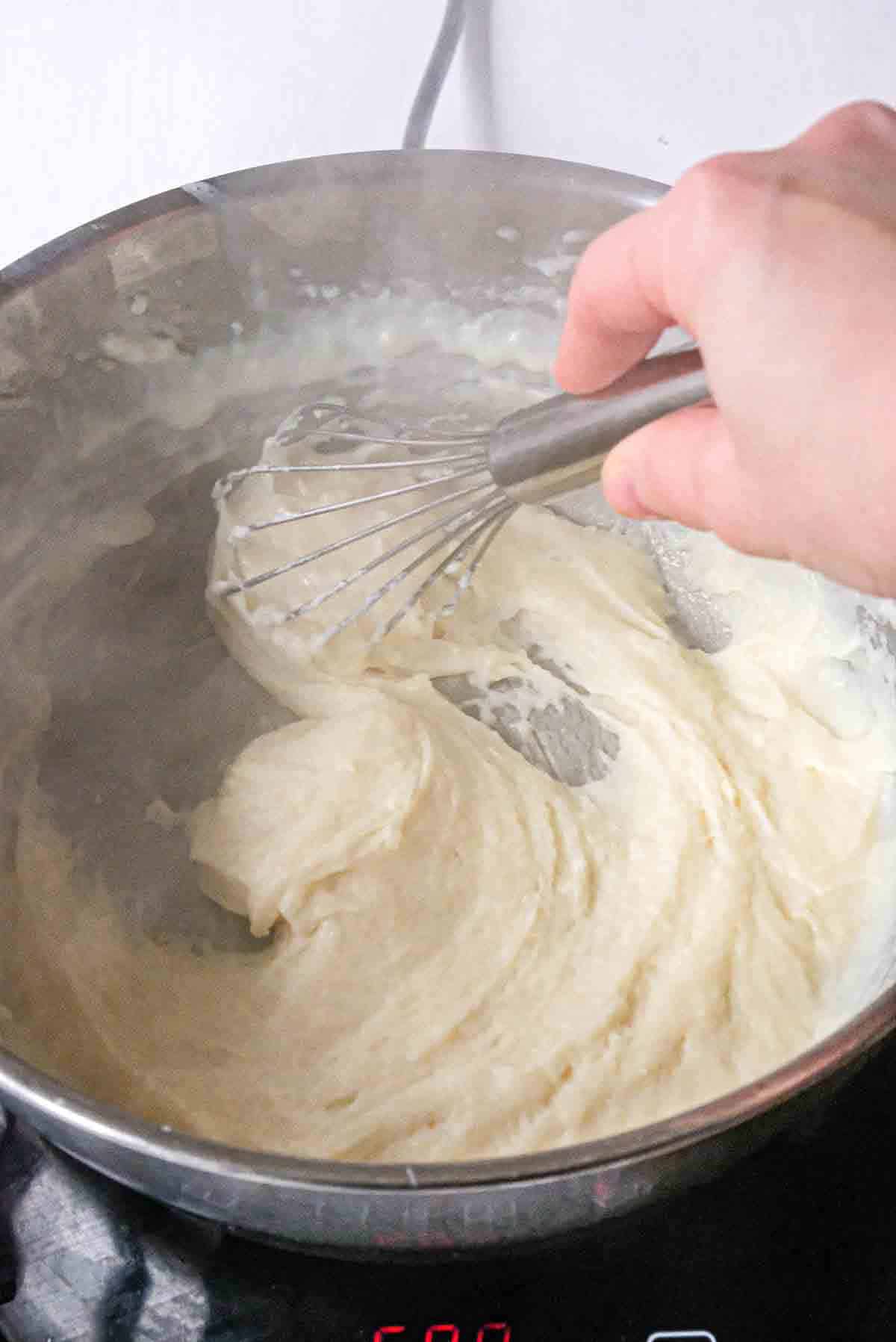

At this point you should have a smooth and consistent sauce. Keep in mind it will continue to thicken as it cools. If the sauce has any lumps or is not your desired consistency, check out the troubleshooting section below.
If you don't plan to use it right away or within 5-10 minutes, cover the sauce with a piece of plastic wrap (stuck directly to the surface of the sauce) or otherwise it will form a skin. If you don't plan to use the sauce within 30 minutes then see below tips for making ahead and storing (refrigerating or freezing).
A few crucial elements are important to be aware of:
- The importance of whisking: stirring continuously is mentioned in many recipes and this is the most important factor. By stirring vigorously and consistently, you ensure the flour absorbs the milk more uniformly.
- Milk temperature= not so important: some recipes suggest the milk should be hot when introduced. In my experience it doesn't make a difference.
- The rate at which the milk is introduced: some recipes recommend adding the milk a little at a time, ⅓ at a time, or all at once. In my experience it's simply easier to add the milk ⅓ at a time but you can also add it all at once like in this video demonstration for bechamel from a Michelin star restaurant and still get a smooth sauce as long as you whisk sufficiently.

Can you make ahead bechamel?
Bechamel can easily be made ahead and refrigerated for up to 3 days or frozen for up to three weeks. When ready to use simply defrost and reheat in a pan, adding enough liquid to achieve a pouring consistency.
1 -3 days before: bechamel can easily be made one to two days before you intend to use it. Simply make the sauce, pour it into a container with a lid, and cover the surface with plastic wrap laid directly on the surface of the sauce. When ready to use, take it out of the fridge and heat again in a sauce pan, whisking it again to make sure it's smooth and consistent. If the texture if too thick or thin, continue cooking or add more milk. See the troubleshooting section below for more details.
4+ days before: if you plan to make bechamel 3-4 days or more before you use it then the best thing to do is to freeze it. Follow the same packaging method above. When you want to use it, defrost and then reheat/whisk as indicated above.
Can you freeze bechamel?
Yes, bechamel can be frozen for up to 2-3 weeks. Any more than that and ice crystals can form which may alter the texture of the sauce. To freeze bechamel follow the indication above for storing bechamel for 4 days or more.
Troubleshooting common issues with bechamel
The great thing about bechamel is that even if you experience technical difficulties, it's still possible to end up with a perfect sauce
- Lumpy sauce:
- The most common reason for lumps is that the bechamel hasn't been whisked enough or hasn't been whisked fast enough or for long enough. If the sauce is lumpy then the first thing to try is whisking it very thoroughly over medium heat. If you've done that and it's still lumpy, then you can strain the bechamel through a medium to fine mesh sieve with a silicone spatula.
- Another possible reason is if the flour and butter weren't cooked enough before adding the milk. If this is the case, there isn't a lot you can do besides straining the lumpy bechamel through a medium / fine sieve. Keep in mind to cook the sauce sufficiently to avoid food borne illness related to uncooked flour.
- Sauce is too thin: if the sauce is thinner than you want, you can continue cooking it until it thickens. Keep in mind that the sauce will thicken quite a lot after it cools down. A good way to determine if the sauce is the right consistency is to consider that a medium sauce will just coat a wooden spoon while hot. Judge the consistency of the sauce accordingly.
- Sauce is too thick: sauce that's too thick is a really easy fix. Simple add more milk one tablespoon at a time while whisking over medium heat.
- The butter/flour has browned or burned: if the roux has browned, it's up to you whether you are okay with it or want to start over. Most cookbooks say that when making bechamel, the butter should not ever be allowed to brown since the sauce is meant to be white. If the roux is burnt though (as in, black or approaching black and smells acrid) then you should start over or the whole sauce will taste burnt.
- The mixture smells like burning milk: you will have to start over. Sorry. There is nothing redeemable about the flavor of burnt milk.
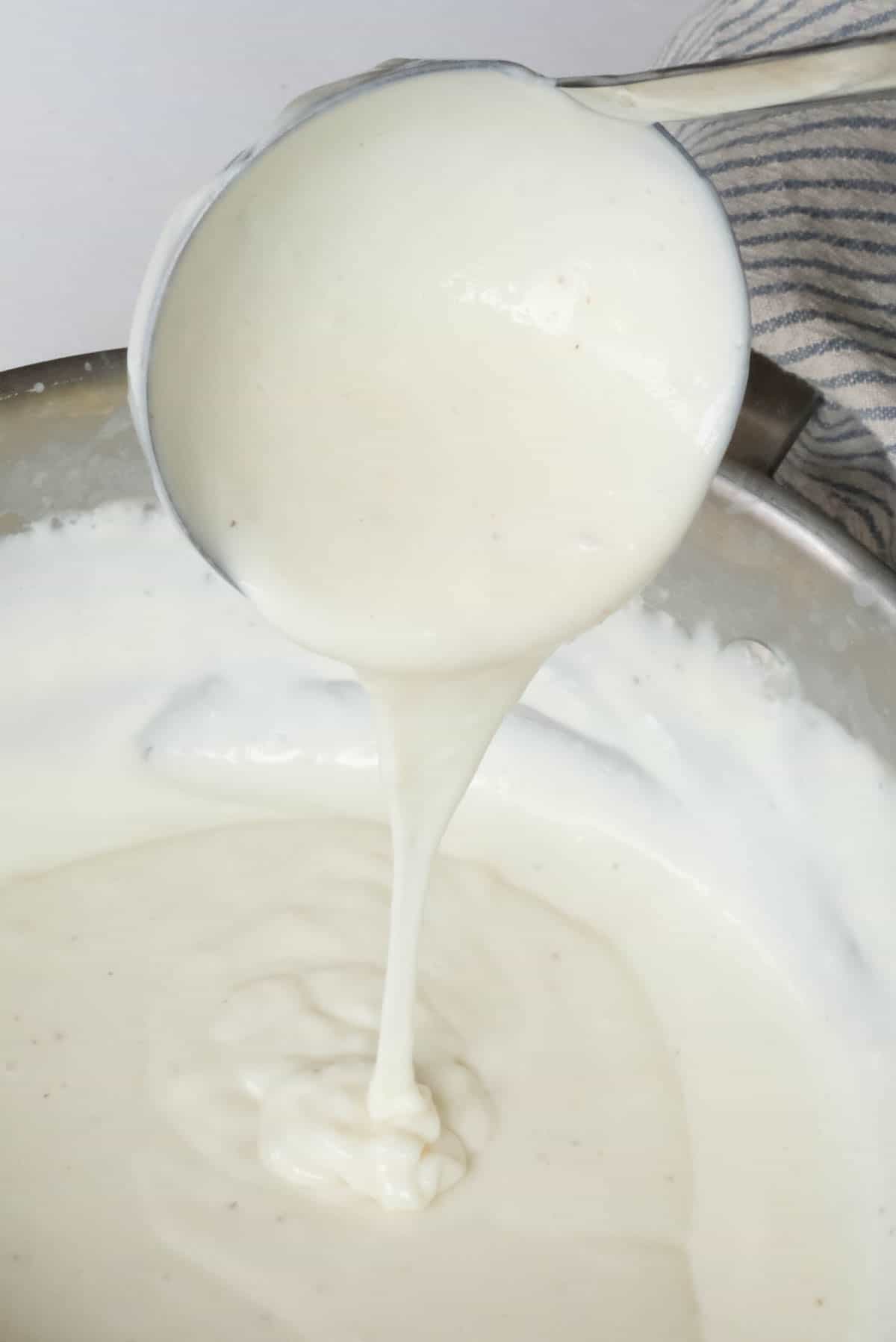
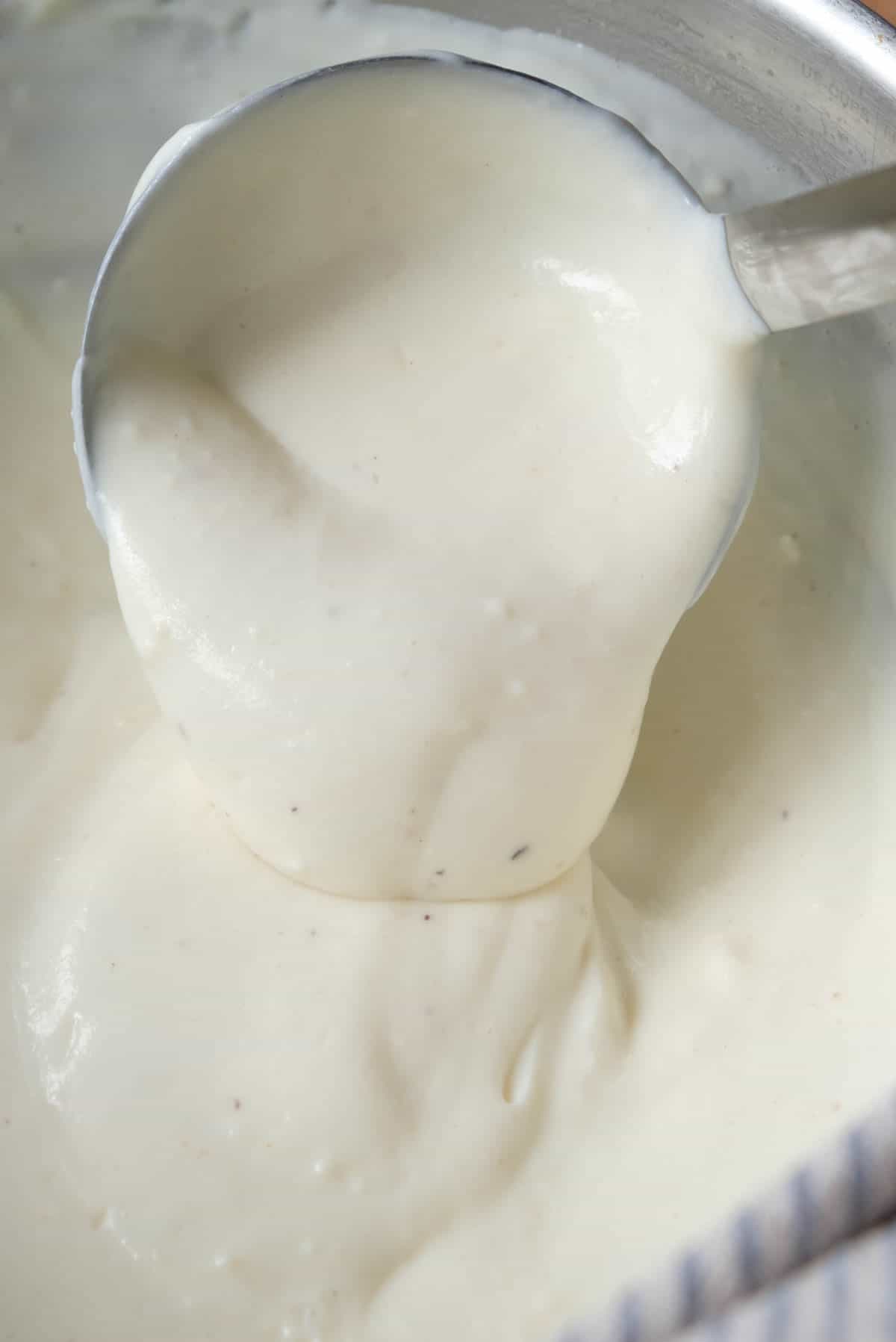
Variations
There are a lot of variations of bechamel sauce. Indeed, bechamel is one of the French mother sauces due to this quality of adaptability that allows for it to be used as a base for a lot of different types of sauces.
Well-known derivatives of bechamel or velouté:
- Cream Sauce: Bechamel with the addition of cream as in Ina Garten's recipe above, or replacement of milk with cream. Both options make for a richer sauce.
- Sauce Mornay: Bechamel with cheese, usually Gruyere in the French tradition but you could also add cheddar for classic macaroni and cheese, parmesan for a parmesan cheese sauce or any other cheese.
- Sauce Parisienne / Sauce Allemande: When velouté sauce is enriched with cream, egg yolks, or both. Basically a bechamel made with stock instead of milk and then enriched with cream / egg yolks.
- Sauce Aurore: A pinkish sauce named after sunset and made by adding concentrated tomato paste to bechamel or velouté.
- Sauce Nantua: a bechamel base flavored with crayfish and traditionally served with the famous Lyonnaise Quenelles.
- Sauce Chivry / Sauce a l’estragon: A lovely herby bechamel enriched with fresh parsley, terragon, chives and chervil as well as white wine. Excellent for poultry, fish or egg dishes.
- Sauce soubise: A sauce made of braised and pureed onions combined with bechamel (or in some cases with rice, as for the classic French dish Veal Prince Orloff).
- Sauce Batarde: A bechamel with the addition of egg yolks, cream, butter and lemon juice. Sometimes called mock hollandaise.
- Sauce moutarde et câpres: bechamel with fresh lemon juice, chopped preserved capers, mustard and finely diced parsley. Great for fish.
- Sauce aux anchois: a bechamel or velouté with the addition of lemon juice, preserved anchovy fillets, garlic and paprika.
Bechamel Substitutions
Some recipes on the internet will tell you that bechamel can't be made with substitutes. But I have it on very good authority that bechamel is highly adaptable. The only constants are fat, starch, and liquid. What you use to meet those requirements is flexible.
The basic principle works with any form of starch and any fat or oil.
On Food and Cooking: The Science and Lore of the Kitchen by Harold McGee p.617
Butter substitutes: Butter can be substituted with basically any fat from plain vegetable oil to coconut oil or even plant based butter.
Flour substitutes: Any starch can be a good substitute for flour. The only thing to keep in mind is that different starches will make sauces with different textures. Some starches (like tapioca) can be more gelatinous, which may not be desirable. Other starches may hydrate differently than flour, like corn starch or potato starch.
Milk substitutes: Dairy milk can be substituted with virtually any liquid including water or stock (vegetable, meat, etc.) and most plant milks.
Technically a bechamel with stock or water is not called a bechamel but is actually a velouté but who's counting right...
If you're really in a pinch you could also substitute heavy whipping cream (⅓ cup cream for every ⅔ cup water), or powdered milk (mix according to package directions).
Do note that certain plant milks can have thickeners that may have unexpected reactions with certain starches. Personally I've made some pretty wild "bechamel" sauces including Oatley Barista oat milk mixed with cornstarch. Would I use it for a dairy-based mac and cheese? No. Was it okay in a pinch to make a creamy base for a sauce? Definitely yes.
Frequently Asked Questions about Bechamel
How to use bechamel
- Thin bechamel combined with cheeses or seasonings makes great creamy white sauces for pastas like macaroni and cheese (for example this Saffron Mac & Cheese), lasagna (like this Ethiopian Lasagna with Homemade Berbere spice in the bechamel), fettuccini Alfredo sauce, or other creamy pastas.
- Thin bechamel can be used to make a rich base for creamy soups like chicken and wild rice, clam chowder, and cream of mushroom.
- Thin bechamel can provide a quick kick-start for creamy stews like beef or mushroom stroganoff.
- Combine medium thick bechamel with vegetables of your choice to make yummy baked dishes like scalloped potatoes, potato, leek or fennel gratin.
- Medium thick bechamel makes a good base for the filling in savory pies like chicken pot pie or fish pie.
- Thick bechamel can be used to make savory souffles like classic cheese souffle.
- Thick bechamel is the starting point for making different kinds of croquettes like Spanish ham and cheese croquettes, Dutch cheese croquettes, and shrimp croquettes.
Resources
The findings in this post are based on the recipes and methods shared in the following cooking resources:
- Mastering the Art of French Cooking by Julia Child, Simone Beck and Louisette Bertholle
- Larousse Gastronomique: The World's Greatest Culinary Encyclopedia
- The Silver Spoon: Traditional Italian Home Cooking Recipes
- Essential of Classic Italian Cooking by Marcella Hazan
- On Food and Cooking: The Science and Lore of the Kitchen by Harold McGee
Recipe
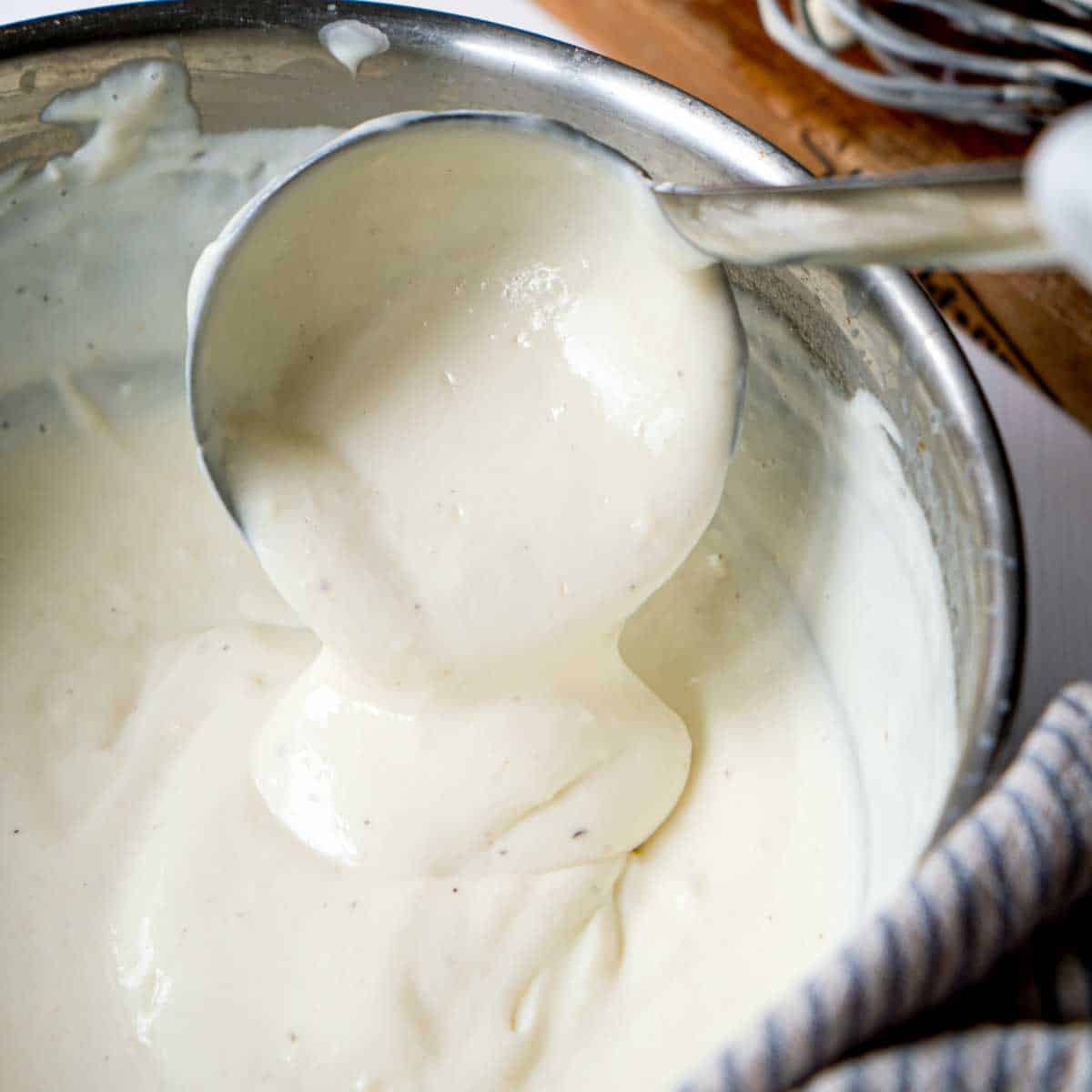
Perfect Bechamel Sauce Every Time (Best Method)
Equipment
- 1 heavy bottomed sauce pan
- 1 wire whisk
Ingredients
- 30 grams butter
- 30 grams flour
- 500 ml milk
- ½ teaspoon salt optional
- ¼ teaspoon freshly grated nutmeg optional
Instructions
- Measure out the flour, butter and milk for your desired sauce thickness and set them close to the stovetop. The process will go very quickly so it should all be at hand.
- Preheat the sauce pan over medium heat.
- Add the butter to the pan and melt it (but don't brown or burn), then add the flour as soon as it's melted. You can also add both at the same time as I have, just make sure the butter doesn't brown on the edges before melting in the center.
- Use the whisk to mix the butter and flour until they are well-combined, and cook the mixture for 3-5 minutes adjusting the temperature as necessary to make sure it doesn't brown. It should begin to smell slightly sweet and nutty. It is okay if it clumps together at this stage, just keep stirring it.
- With the whisk in one hand, pour in the milk in a bit at a time (as little as a quarter cup at a time) and whisk it as fast as is safe, being careful not to splash. It may be helpful to have someone assist you at this stage. The bechamel should take on a stringy consistency as shown in the photo.
- Continue adding milk while whisking, scraping along the edges of the saucepan to reincorporate any bits sticking to the edges of the pan (these can cause lumps later if not mixed in as you go).
- Once all the milk has been poured in, keep cooking for 3-5 minutes while stirring continuously.
- Turn off heat and season as you like (optionally ½ teaspoon salt and ¼ teaspoon nutmeg).

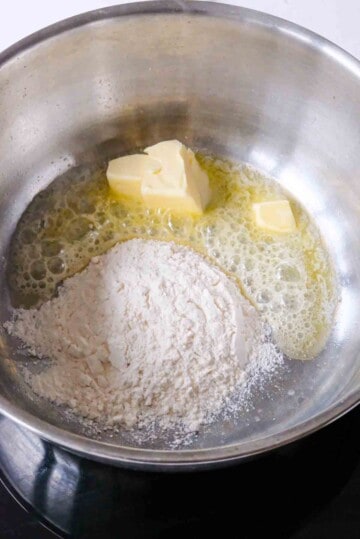
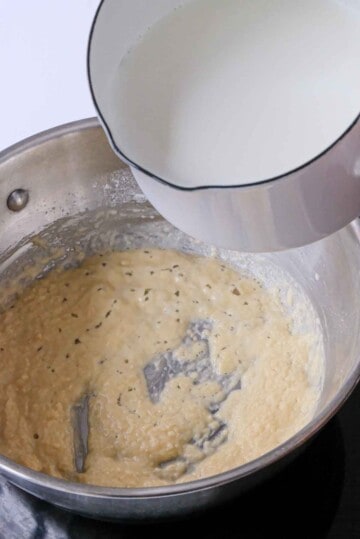
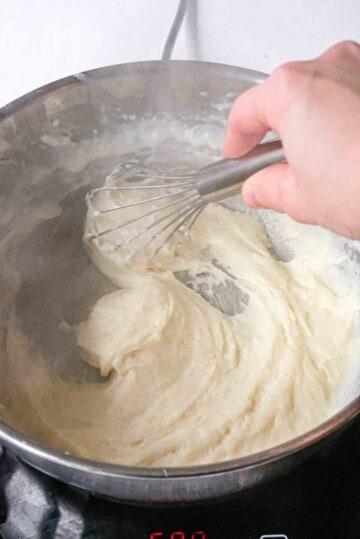
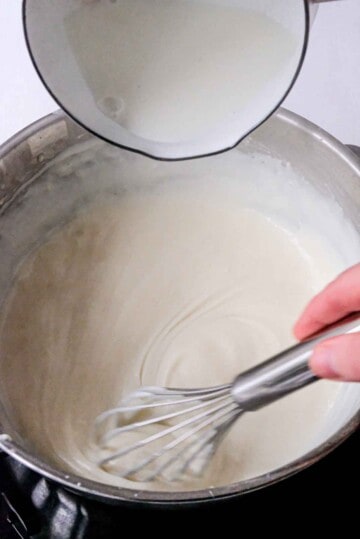
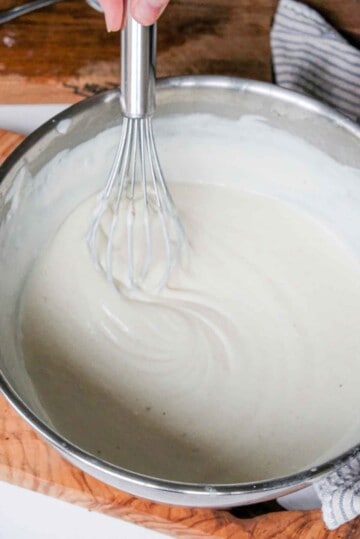
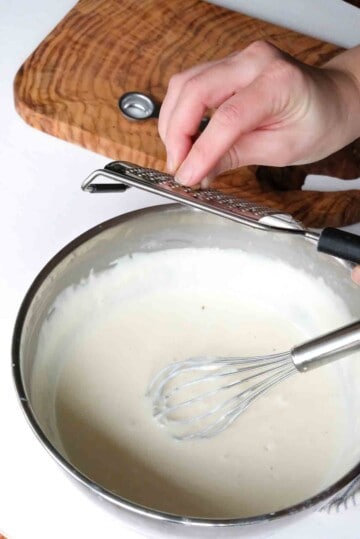

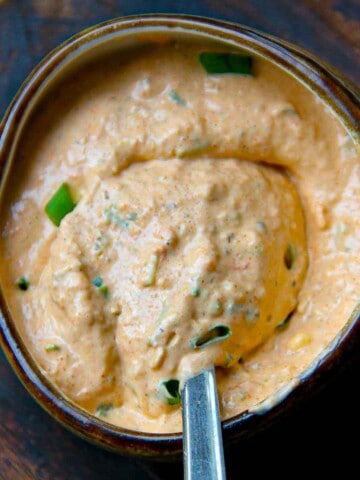
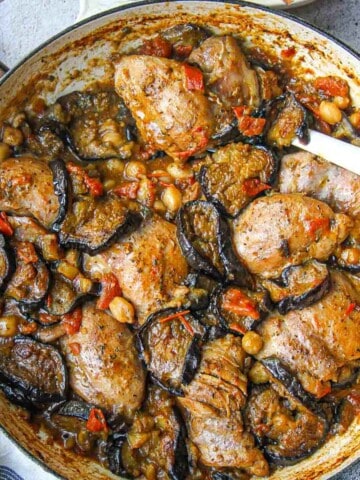
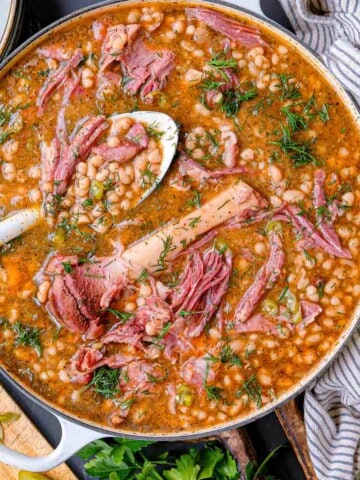
Comments
No Comments